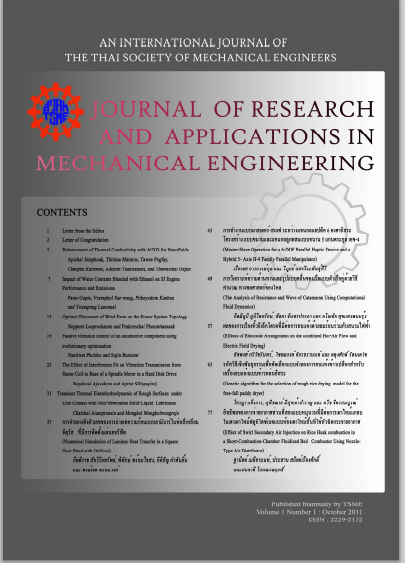The two-phase microchannel flow study of chicken blood on lab-on-a-chip
Main Article Content
Abstract
In previous study, we introduce problems in assembly the polydimethylsiloxane (PDMS) lab-on-a-chip (LOC) devices from literatures; a manual assembly by using acrylic plates and an adhered assembly by using a plasma cleaner. Since electrodes in the devices had been designed to provide a strong dielectrophoretic force by using sputtering and electroplating techniques, the thick electrodes were used. The PDMS LOC was also aimed to use with biological samples to study the different flow patterns of the samples prepared from chicken blood and to solve a PDMS hydrophobic problem from our previous study where the sample cannot flow through a channel of the adhered assembly LOC. Since the chicken blood contains of whole blood and plasma, the sample can be considered as a combination of particle and fluid parts or the two-phase flow. The channels on the PDMS LOC having dimensions of the order of microns can be considered as microchannels; Knudsen number is used to distinguish flow regimes. From the experiment study, the flow problem has still existed in the adhered method but the flow problem did not exist on the manual method with a new-acrylic-plate set. Slip flow occurred at the leak areas because interactions between the sample and walls became significant. Different flow patterns occurred in the channels of workable LOCs in different channel distances. No slip (continuum) flow occurred at the middle path where pressure drop was decreased. The hydrophobic problem was solved by using Bovine Serum Abumin solution to reduce PDMS hydrophobic behavior and this solution did not affect red blood cells because of none damaged cells.
Article Details
This work is licensed under a Creative Commons Attribution-NonCommercial-ShareAlike 4.0 International License.
References
[2] Mark, D., Haeberle, S., Roth, G., Von Stetten, F. and Zengerle, R. (2010). Microfluidic lab-on-a-chip platforms: Requirements, characteristics and applications. In: S. Kakaç, B. Kosoy, D. Li, and A. Pramuanjaroenkij, eds., Microfluidics Based Microsystems Fundamentals and Applications, Springer: Netherland, pp. 305 – 376.
[3] Haeberle, S. and Zengerle, R. (2007). Microfluidic platforms for lab-on-a-chip applications, Lab Chip, vol.7, 1094 – 1110.
[4] Kakaç, S., Liu, H. and Pramuanjaroenkij, A. (2012). Heat Exchangers: Selection, Rating, and Thermal Design, ISBN: 1-43984-990-0, CRC Press, Boca Raton.
[5] Zhang, M. Z. (2007). Nano/Microscale Heat Transfer, ISBN: 0-07143-674-X, McGraw-Hill, New York.
[6] Kandlikar, S., Garimella, S., Li, D., Colin, S. and King, M. R.( 2005). Heat transfer and fluid flow in minichannels and microchannels, ISBN-13: 978-0080445274, Oxford, UK.
[7] Pramuanjaroenkij, A., Napinij, U., Teingtit1, W., Boonthueng, S., Maturos, T., Tanom, L., Tuantranont, A. and Kakaç, S. (2011).Feasibility study on Lab-on-a-chip fabrication in Kasetsart University, Chalermphrakiat Sakon Nakhon Province Campus, The 2nd TSME-ICoME International Conference on Mechanical Engineering, Sheraton Krabi Beach Resort, krabi,Thailand.
[8] Cetin, B. (2009). Microfluidic continuous separation of particles and cells by AC-dielectrophoresis, Ph.D. dissertation, Graduate School of Vanderbilt University, Tennessee, USA.



